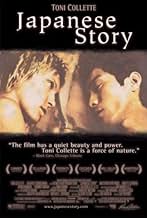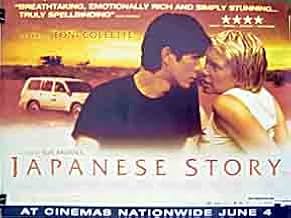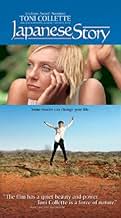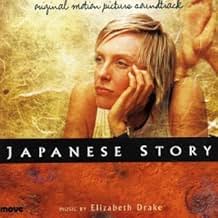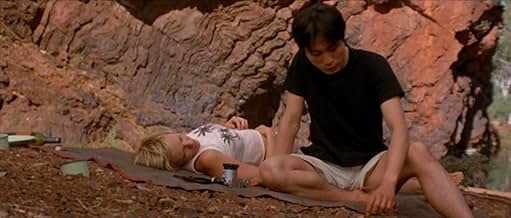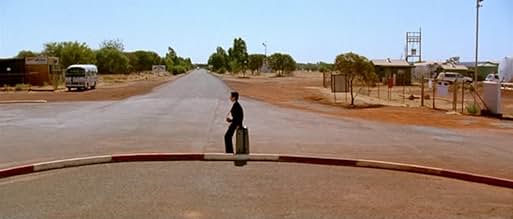IMDb RATING
6.8/10
6.9K
YOUR RATING
Against the background of an Australian desert, Sandy, a geologist, and Hiromitsu, a Japanese businessman, play out a story of human inconsequence in the face of the blistering universe. The... Read allAgainst the background of an Australian desert, Sandy, a geologist, and Hiromitsu, a Japanese businessman, play out a story of human inconsequence in the face of the blistering universe. The end of the journey leaves no one capable of going back to where they started from.Against the background of an Australian desert, Sandy, a geologist, and Hiromitsu, a Japanese businessman, play out a story of human inconsequence in the face of the blistering universe. The end of the journey leaves no one capable of going back to where they started from.
- Awards
- 20 wins & 13 nominations total
Jules Hutchinson
- Canteen Worker
- (as Jules Hutchison)
- Director
- Writer
- All cast & crew
- Production, box office & more at IMDbPro
Featured reviews
Spoilers - hopefully kept to a minimum, but you are duly warned !!
Thanks to the summary line 'The less you know about this film, the better', I curbed my urge to find out more about this film before watching it, something that I'm often tempted to do. If I had known the full plot, I would have been deprived of the dramatic experience of fully empathising with the emotions of the characters.
As others have said, this film is in three parts, call it three acts if you like plays or three movements if you like concertos. The first part is rather cliché, even banal, perhaps by intention. The scene of being stuck in the sand with the wheels spinning feverishly but going nowhere does strike a chord with those of us who have had similar experiences, on sand as well as on snow. The second part starts to intrigue and has all the necessary build-up. It's the third and final part, however, that has given me a cinematic experience that I've never had before. 'Powerful' will be an understatement. 'Powerful' however is not a fair description, because the word conjures up an image of being hit by an abrupt emotional blow. It's not quite like that. There's a sustained drive of waves of emotions, layer after layer. I know I'm getting myself into a lot of trouble saying this, but I think that it needs a woman director to pull this off. It also needs an actress in the caliber of Toni Colette.
Can't finish without mentioning the music. There are in fact a lot of scenes with absolutely no sound, not even the ambiance noise of the vast outback. But when there is music, they're the best. One good example is the love-making scene. But that is soon dwarfed compared with the hauntingly beautiful piece of music that is the background, sometimes just noticeable, sometimes coming forth, throughout the last twenty minutes of the film. Essentially, it alternates between a simple phrase of 8 notes on a plucked instrument and a haunting soprano chorus, blending in perfectly with the mood of the film.
Thanks to the summary line 'The less you know about this film, the better', I curbed my urge to find out more about this film before watching it, something that I'm often tempted to do. If I had known the full plot, I would have been deprived of the dramatic experience of fully empathising with the emotions of the characters.
As others have said, this film is in three parts, call it three acts if you like plays or three movements if you like concertos. The first part is rather cliché, even banal, perhaps by intention. The scene of being stuck in the sand with the wheels spinning feverishly but going nowhere does strike a chord with those of us who have had similar experiences, on sand as well as on snow. The second part starts to intrigue and has all the necessary build-up. It's the third and final part, however, that has given me a cinematic experience that I've never had before. 'Powerful' will be an understatement. 'Powerful' however is not a fair description, because the word conjures up an image of being hit by an abrupt emotional blow. It's not quite like that. There's a sustained drive of waves of emotions, layer after layer. I know I'm getting myself into a lot of trouble saying this, but I think that it needs a woman director to pull this off. It also needs an actress in the caliber of Toni Colette.
Can't finish without mentioning the music. There are in fact a lot of scenes with absolutely no sound, not even the ambiance noise of the vast outback. But when there is music, they're the best. One good example is the love-making scene. But that is soon dwarfed compared with the hauntingly beautiful piece of music that is the background, sometimes just noticeable, sometimes coming forth, throughout the last twenty minutes of the film. Essentially, it alternates between a simple phrase of 8 notes on a plucked instrument and a haunting soprano chorus, blending in perfectly with the mood of the film.
In an age when criticism has become debased and few people are really certain about what constitutes true worth in art, it is difficult to use the word "masterpiece" about any film. And yet that word is applicable here. At first this film appears to be just a bog-standard romantic love story, in the Hollywood mould, about two very different characters who meet and fall in love in unusual circumstances. Opposites attract, and so on.
However, as the story unfolds one becomes aware that there are many more levels to it than one would normally expect. Everything, from the title to incidental characters and the spectacular images of the desert, has been carefully thought out. It raises profound questions about a fashionable subject: identity, but also about love itself. Are these characters in love, or is it merely the terrifying starkness of the Australian outback that has thrown them together? Finally a third person enters the relationship, who complicates matters even further. Despite the romantic overtones of this film it is lifted, ultimately, by its absolute realism. Small gestures betoken whole story lines and glimpses of other characters throw the protagonists into sharp relief. Other influences begin to trickle through: Yasujiro Ozu, Peter Weir (in his early days), Japanese Haiku. And yet this is an entirely original work.
This film had a huge emotional impact on me, but it also made me think, about my own life and about the choices I've made. It did everything that a genuine work of art should do, and without any of the fanfare that we, in the West, have come to associate with art. Small wonder that it got little of the attention that in previous eras it would have attracted. Watch it, and discover that it is still possible to make a classic.
However, as the story unfolds one becomes aware that there are many more levels to it than one would normally expect. Everything, from the title to incidental characters and the spectacular images of the desert, has been carefully thought out. It raises profound questions about a fashionable subject: identity, but also about love itself. Are these characters in love, or is it merely the terrifying starkness of the Australian outback that has thrown them together? Finally a third person enters the relationship, who complicates matters even further. Despite the romantic overtones of this film it is lifted, ultimately, by its absolute realism. Small gestures betoken whole story lines and glimpses of other characters throw the protagonists into sharp relief. Other influences begin to trickle through: Yasujiro Ozu, Peter Weir (in his early days), Japanese Haiku. And yet this is an entirely original work.
This film had a huge emotional impact on me, but it also made me think, about my own life and about the choices I've made. It did everything that a genuine work of art should do, and without any of the fanfare that we, in the West, have come to associate with art. Small wonder that it got little of the attention that in previous eras it would have attracted. Watch it, and discover that it is still possible to make a classic.
Australia has given the cinema some wonderfully adept and strikingly effective female actors in the past twenty years or so, Judy Davis starting a parade that includes Nicole Kidman, Cate Blanchett and Toni Collett among others. Collett has the ability to convincingly inhabit many different roles, her part as the depressed, suicidal mom in "About a Boy" being one of her most memorable.
"Japanese Story" is a quirky tale about Sandy Edwards, Collette, an Australian geologist in her, I would guess, mid-thirties. She's ordered to squire about the son of a Japanese industrialist whose investment in a major project is dearly desired by her bosses. The young man, handicapped by a very poor grasp of English and virtually none of Australian, is played by Gotaro Tsunashima. He might be well known in his native country but he was a new screen presence for me.
Sandy takes him on a tour of an achingly eerie, desolate, windswept part of Western Australia. Must of the movie was filmed in the Pilbara Desert, still aborigine country.
Sandy and her charge encounter adventurous situations while, no surprise, a romance springs up. Why Sandy would be attracted to the younger gentleman is never explained and it really shouldn't have been. "Japanese Story" asks the viewer to simply accept that liaisons arise without any deep preliminary exposition of character.
I won't reveal the plot, somewhat unexpected, but fate insures that this affair doesn't proceed swimmingly. What makes the movie is Collette's superb and affecting acting. I cared about her while knowing relatively little about her character's past life other than she hasn't completely resolved mom-daughter issues.
Nothing in this film could impel me to ever wish to go to the Pilbara Desert but it does excite my desire to see Collette take on many more challenging roles. She has a strong future-I hope.
8/10. See it if it plays near you, rent it later if not. You won't be sorry.
"Japanese Story" is a quirky tale about Sandy Edwards, Collette, an Australian geologist in her, I would guess, mid-thirties. She's ordered to squire about the son of a Japanese industrialist whose investment in a major project is dearly desired by her bosses. The young man, handicapped by a very poor grasp of English and virtually none of Australian, is played by Gotaro Tsunashima. He might be well known in his native country but he was a new screen presence for me.
Sandy takes him on a tour of an achingly eerie, desolate, windswept part of Western Australia. Must of the movie was filmed in the Pilbara Desert, still aborigine country.
Sandy and her charge encounter adventurous situations while, no surprise, a romance springs up. Why Sandy would be attracted to the younger gentleman is never explained and it really shouldn't have been. "Japanese Story" asks the viewer to simply accept that liaisons arise without any deep preliminary exposition of character.
I won't reveal the plot, somewhat unexpected, but fate insures that this affair doesn't proceed swimmingly. What makes the movie is Collette's superb and affecting acting. I cared about her while knowing relatively little about her character's past life other than she hasn't completely resolved mom-daughter issues.
Nothing in this film could impel me to ever wish to go to the Pilbara Desert but it does excite my desire to see Collette take on many more challenging roles. She has a strong future-I hope.
8/10. See it if it plays near you, rent it later if not. You won't be sorry.
8=G=
It would be impossible to say anything substantially meaningful about "Japanese Story" without spoiling the film for those who have not seen it. Suffice it to say, it's set in Australia and works with a an Aussie woman (Colette) and a Japanese man (Hiromitsu) to build slowly to an emotionally potent situation - a series of moments - and then lingers in the denouement allowing the audience to savor the emotions evoked. For some, those feelings may be nil. For others they may be powerful and overwhelming. Personally, I wept. Objectively, the film, about a woman by women, is well crafted and Colette's performance is outstanding. The film deserves high marks in all aspects from cinematography to music to casting, etc. However, when the closing credits roll, your experience will have been as unique as yourself. And whatever that experience is, it will be less if you know the outcome in advance. (B+)
This is as much an Australian story as a Japanese one. We are not about to turn Japanese, but our close economic relationship over the last 50 years has to some extent transcended the cultural gap that divides us, and the bitterness of World War 2. On one level, this is a very personal story of two people from different cultures who become closer than they might have imagined. On another level it examines two very different cultures tied together by economic necessity. These themes are played out in a truly awe- inspiring ancient landscape, which, as others have remarked, is a character on its own.
I've not been to the Pilbara, but I've been to places like it elsewhere in Australia, and they tend to have the effect of reminding you of the fragility of your existence. The Aborigines (represented here by only a gas station attendant) regarded themselves as belonging to the land and here you can see why. It's not clear what Tachibana Hiromitsu, the rich businessman's son, is looking for in the desert, but he certainly feels its power. Just why Sandy the tough female geologist comes to harbour tender feelings towards him is not evident either; perhaps it's the mothering instinct at work- he's not an adaptable kind of guy and perhaps she senses his vulnerability.
Apart from the firm refusal to turn this film into a romantic comedy, despite some `When Harry Met Sally' moments, there are several other things going for it. First there is Toni Collette's entirely convincing performance which overcomes some weaknesses in the storyline (and improbabilities in her character). She has a lot of ground to cover, from boredom to hilarity, from dislike to intimacy, and from terror to melancholy.
Second, the cinematography fully exploits the scenery without detracting from the story. Much of `Japanese Story' was filmed around Port Headland in the Pilbara, but it's not a tourist brochure. Third, even the minor parts are played with precision (eg John Howard as the BHP man and Yukimo Tanaka as Tachibana's wife). It's difficult to judge just how effective Gotaro Tsunashima is you'd need to be Japanese, I guess, and anyway the script is from an Australian, Alison Tilson. To my eyes he seems real enough, if we accept he's from a very privileged and sheltered background. It's interesting that Sandy seems to be the initiator of their intimacy (he doesn't resist!).
I think this film would hold up well anywhere. It has more than the usual emotional content for an Australian film, an intriguing and poignant story, good acting, and it's not too long. The admission price is also considerably cheaper than an air ticket to Port Headland.
I've not been to the Pilbara, but I've been to places like it elsewhere in Australia, and they tend to have the effect of reminding you of the fragility of your existence. The Aborigines (represented here by only a gas station attendant) regarded themselves as belonging to the land and here you can see why. It's not clear what Tachibana Hiromitsu, the rich businessman's son, is looking for in the desert, but he certainly feels its power. Just why Sandy the tough female geologist comes to harbour tender feelings towards him is not evident either; perhaps it's the mothering instinct at work- he's not an adaptable kind of guy and perhaps she senses his vulnerability.
Apart from the firm refusal to turn this film into a romantic comedy, despite some `When Harry Met Sally' moments, there are several other things going for it. First there is Toni Collette's entirely convincing performance which overcomes some weaknesses in the storyline (and improbabilities in her character). She has a lot of ground to cover, from boredom to hilarity, from dislike to intimacy, and from terror to melancholy.
Second, the cinematography fully exploits the scenery without detracting from the story. Much of `Japanese Story' was filmed around Port Headland in the Pilbara, but it's not a tourist brochure. Third, even the minor parts are played with precision (eg John Howard as the BHP man and Yukimo Tanaka as Tachibana's wife). It's difficult to judge just how effective Gotaro Tsunashima is you'd need to be Japanese, I guess, and anyway the script is from an Australian, Alison Tilson. To my eyes he seems real enough, if we accept he's from a very privileged and sheltered background. It's interesting that Sandy seems to be the initiator of their intimacy (he doesn't resist!).
I think this film would hold up well anywhere. It has more than the usual emotional content for an Australian film, an intriguing and poignant story, good acting, and it's not too long. The admission price is also considerably cheaper than an air ticket to Port Headland.
Did you know
- GoofsWhen the QANTAS jet to Kyoto leaves, it is actually leaving from the Perth domestic airport. The international terminal, where it would really leave from, and the Darling Ranges to the east, are clearly visible in the background.
- Crazy creditsOur thanks to the people of Nyamal, Ngarluma, Yinjibarndi, Bunjima and Nyiparli Nations.
- ConnectionsFeatured in Inside Japanese Story: an evening with the film-makers (2004)
- SoundtracksABC News Theme
(1986)
Written by Tony Ansell (as T. Ansell) and Peter Wall (as P. Wall)
Published by ABC Music Publishing and
Kindly reproduced with the permission of the Australian Broadcasting Corporation
- How long is Japanese Story?Powered by Alexa
Details
- Release date
- Country of origin
- Official sites
- Languages
- Also known as
- Японская история
- Filming locations
- Production companies
- See more company credits at IMDbPro
Box office
- Budget
- $5,740,000 (estimated)
- Gross US & Canada
- $647,054
- Opening weekend US & Canada
- $23,962
- Jan 4, 2004
- Gross worldwide
- $4,098,613
- Runtime1 hour 46 minutes
- Color
- Sound mix
- Aspect ratio
- 2.35 : 1
Contribute to this page
Suggest an edit or add missing content








